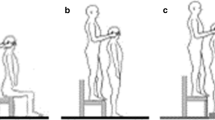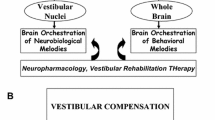Summary
In previous studies a contribution of vision to vestibular-dependent muscle responses during free-fall was found in the intact monkey, and the role of remaining labyrinthine afferents in compensation of these postural reactions was studied in vestibular neurectomized monkeys. In the present investigation we have compared the role of visual motion cues in the recovery of muscle responses to fall in unilateral (U.N.) and bilateral vestibular neurectomized (B.N.) baboons. During free-fall, electromyographic (EMG) responses were recorded from splenius capitis, soleus and tibialis anterior muscles. EMG activities were recorded in two randomly presented conditions: with normal motion of the visual world (NV) and with the visual world stabilized with respect to the baboon's head (SV) until 6 weeks after surgery.
In B.N. baboons, results showed that condition SV was accompanied by a very strong motor depression during the entire test period. A greater decrease was observed in the splenius and soleus muscles. In U.N. baboons, significantly depressed EMG responses were recorded in the SV condition during the first two stages of compensation only (0–2 weeks), in all tested muscles except the tibialis anterior muscle. On the other hand, these motor depressions appeared to depend upon the level of neuronal resting activity in the vestibular nuclei.
It is inferred that the partial recovery of muscle responses to fall observed in B.N. baboons in the NV condition is mainly due to visual information concerning motion, which replaces to the labyrinthine afferents. In U.N. baboons, the visual motion cues would fulfil only a transitory substitution function by supplying the decrease of neuronal activity in the vestibular nuclei. Later on, full compensation would be carried out by means of the remaining labyrinth.
Similar content being viewed by others
References
Allum JHJ, Graf W, Dichgans J, Schmidt CL (1976) Visualvestibular interactions in the vestibular nuclei of the goldfish. Exp Brain Res 26: 463–485
A'zzena GB, Tolu E, Mameli O (1978) Responses of vestibular units to visual input. Arch Ital Biol 116: 120–129
Berthoz A, Anderson J (1971) Frequency analysis of vestibular influence on extensor motoneurons. II. Relationship between neck and forelimb extensors. Brain Res 34: 376–380
Berthoz A, Lacour M, Soechting J, Vidal PP (1979) Role of vision in the control of posture during linear motion. In: Granit R, Pompeiano O (eds) Reflex control of movement and posture. Progress in brain research, vol 50. Elsevier, Amsterdam, New York, pp 197–209
Carli G, Diete-Spiff K, Pompeiano O (1967) Responses of the muscle spindles and of the extrafusal fibres in an extensor muscle to stimulation of the lateral vestibular nucleus in the cat. Arch Ital Biol 105: 209–242
Courjon JH, Jeannerod M, Ossuzio I, Schmidt R (1977) The role of vision in compensation of vestibulo-ocular reflex after hemilabyrinthectomy in the cat. Exp Brain Res 28: 235–248
Ewald JR (1892) Physiologische Untersuchungen über das Endorgan des Nervus Octavus. Bergmann, Wiesbaden
Fredrickson JM, Schwarz D, Kornhuber HM (1966) Convergence and interaction of vestibular and deep somatic afferents upon neurons in the vestibular nuclei of the cat. Acta Otolaryngol (Stockh) 61: 168–188
Greenwood RJ, Hopkins AP (1976) Muscle responses during sudden falls in man. J Physiol (Lond) 254: 507–518
Kato M, Tanji J (1971) The effect of electrical stimulation of Deiter's nucleus upon hindlimb gamma motoneurons in the cat. Brain Res 30: 385–395
Kolb G (1955) Untersuchungen über zentrale Kompensation und Kompensationsbewegungen einseitig entarteter Frösche. Z Vergl Physiol 37: 136–160
Lacour M, Xerri C, Hugon M (1978a) Muscle responses and monosynaptic reflexes in falling monkey: role of the vestibular system. J Physiol (Paris) 74: 427–438
Lacour M, Vidai PP (1978b) Influence de l'environnement visuel sur les réponses musculaires précoces du Singe (Papio papio) en chute libre. J Physiol (Paris) 74: 9A
Lacour M, Xerri C, Hugon M (1979) Compensation of postural reactions to fall in the vestibular neurectomized monkey: Role of the remaining labyrinthine afferences. Exp Brain Res 37: 563–580
Magnus R (1924) Körperstellung. Springer, Berlin
McCabe BF, Ryu JH (1969) Experiments on vestibular compensation. Laryngoscope 79: 1728–1736
McCabe BF, Ruy JH, Sekitani T (1972) Further experiments on vestibular compensation. Laryngoscope 82: 381–396
Melvill Jones G, Watt DGD (1971) Muscular control of landing from unexpected falls in man. J Physiol (Lond) 219: 729–737
Pompeiano O, Brodal A (1957) The origin of vestibulospinal fibres in the cat. An experimental anatomical study, with comments on the descending medial longitudinal fasciculus. Arch Ital Biol 95: 168–195
Precht W, Shimazu H, Markham CH (1966) A mechanism of central compensation of vestibular function following hemilabyrinthectomy. J Neurophysiol 29: 996–1010
Precht W (1974) Characteristics of vestibular neurons after acute and chronic labyrinthine destruction. In: Kornhuber HH (ed) Vestibular system. Springer, Berlin Heidelberg New York (Handbook of sensory physiology, vol 6, Part II, pp 451–462)
Putkonen PTS, Courjon JH, Jeannerod M (1977) Compensation of postural effects of hemilabyrinthectomy in the cat. A sensory substitution process. Exp Brain Res 28: 249–257
Raymond J, Sans A (1977) Electrophysiological evidence of somatosensory afferents to primary vestibular nuclei. Proc Int Union Physiol Sci 13: 621
Rubin AM, Liedgren SRC, Odkvist LM, Milne AC, Fredrickson JM (1978) Labyrinthine and somatosensory convergence upon vestibulospinal neurons. Acta Otolaryngol (Stockh) 86: 251–259
Thomas A (1940) Equilibre et équilibration. Masson, Paris
Vidal PP, Lacour M, Berthoz A (1979) Contribution of vision to muscle responses in monkey during free-fall: Visual stabilization decreases vestibular-dependent responses. Exp Brain Res 37: 241–252
Watt DGD (1976) Responses of cat to sudden falls: An otolithoriginating reflex assisting landing. J Neurophysiol 39: 257–265
Wilson VJ, Yoshida M (1969) Comparison of effects of stimulation of Deiter's nucleus and medial longitudinal fasciculus on neck, forelimb, and hindlimb motoneurones. J Neurophysiol 32: 743–758
Xerri C, Lacour M (1980) Compensation des déficits posturaux et cinétiques après neurectomie vestibulaire unilatérale chez le chat. Rôle de l'activité sensori-motrice. Acta Otolaryngol (Stockh) (in press)
Author information
Authors and Affiliations
Additional information
Preliminary results were presented at the Association des Physiologistes (Lille 1979)
Rights and permissions
About this article
Cite this article
Lacour, M., Xerri, C. Compensation of postural reactions to free-fall in the vestibular neurectomized monkey. Exp Brain Res 40, 103–110 (1980). https://doi.org/10.1007/BF00236668
Received:
Issue Date:
DOI: https://doi.org/10.1007/BF00236668




